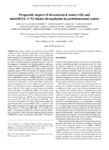Mostrar o rexistro simple do ítem
Prognostic impact of disseminated tumor cells and microRNA-17-92 cluster deregulation in gastrointestinal cancer
| dc.contributor.author | Valladares-Ayerbes, Manuel | |
| dc.contributor.author | Blanco, Moisés | |
| dc.contributor.author | Haz, Mar | |
| dc.contributor.author | Medina, Vanessa | |
| dc.contributor.author | Iglesias-Díaz, Pilar | |
| dc.contributor.author | Lorenzo-Patiño, María J. | |
| dc.contributor.author | Reboredo, Margarita | |
| dc.contributor.author | Santamarina, Isabel | |
| dc.contributor.author | Figueroa, Angélica | |
| dc.contributor.author | Antón-Aparicio, Luis M. | |
| dc.contributor.author | Calvo, Lourdes | |
| dc.date.accessioned | 2018-04-23T10:49:48Z | |
| dc.date.available | 2018-04-23T10:49:48Z | |
| dc.date.issued | 2011-07-04 | |
| dc.identifier.citation | Valladares-Ayerbes M, Blanco M, Haz M, Medina V, Iglesias-Díaz P, Lorenzo-Patiño MJ, et al. Prognostic impact of disseminated tumor cells and microRNA-17-92 cluster deregulation in gastrointestinal cancer. Int J Oncol. 2011;39:1253-1264 | es_ES |
| dc.identifier.issn | 1019-6439 | |
| dc.identifier.issn | 1791-2423 | |
| dc.identifier.uri | http://hdl.handle.net/2183/20599 | |
| dc.description.abstract | [Abstract] The presence of tumor cells in the bone marrow (BM) could be relevant to identifying high risk of disease progression and death in gastrointestinal cancer. However, the molecular profile associated with disseminated tumor cells (DTCs) homing to the BM has yet to be defined. MicroRNAs (miRNA) play key roles in cellular processes implicated in cancer. Thus, we investigated in 38 patients with colorectal, gastric or pancreatic cancer whether the presence of BM-DTCs is associated with a specific miRNA tumor profile and analyzed their potential prognostic impact. DTCs were detected by immunocytochemistry and anti-cytokeratin antibodies in 42.1% of the patients. miRNAs were isolated from formalin-fixed, paraffin-embedded tumors. qRT-PCR was used for miRNA profiling. No significant associations were found among DTC detection and miRNA deregulation. Kaplan-Meier curves demonstrated significantly reduced progression-free survival (PFS) and overall survival (OS) in the DTC-positive patients. Although miR-21 was upregulated in 90.6% of the tumors, no associations with outcomes were found. miR-17 and miR-20a (miRNA-17-92 cluster) were upregulated in 33.3 and 42.4%, respectively. Upregulation of both was correlated and found in 30.3%. Univariate analysis shows that increasing values for miR-20a were significantly associated with reduced PFS (HR 1.022; p=0.016) and OS (HR 1.027; p=0.003). In multivariate Cox models, DTC positivity (HR 4.07; p=0.005) and miR-17 overexpression (HR 2.11; p=0.003) were significantly associated with a higher risk of disease progression. The presence of DTCs in the BM (HR 3.98; p=0.010) and a miR-17 overexpression (HR 2.62; p<0.001) were also associated with a risk of death. Our study suggests that the presence of BM-DTCs and the upregulation of the miR-17-92 cluster in tumors are both significant but independent prognostic markers in gastrointestinal cancer patients. | es_ES |
| dc.description.sponsorship | Instituto de Salud Carlos III; PI061541 | es_ES |
| dc.description.sponsorship | Galicia. Conselleria de Innovación, Industria e Comercio; PGIDT01PXI90001PR | es_ES |
| dc.description.sponsorship | Xunta de Galicia; PS 08/77 | es_ES |
| dc.language.iso | eng | es_ES |
| dc.publisher | Spandidos | es_ES |
| dc.relation.uri | http://dx.doi.org/10.3892/ijo.2011.1112 | es_ES |
| dc.subject | Gastrointestinal cancer | es_ES |
| dc.subject | Disseminated tumor cells | es_ES |
| dc.subject | Micro-RNA | es_ES |
| dc.subject | Prognostic | es_ES |
| dc.subject | Real-time PCR | es_ES |
| dc.title | Prognostic impact of disseminated tumor cells and microRNA-17-92 cluster deregulation in gastrointestinal cancer | es_ES |
| dc.type | info:eu-repo/semantics/article | es_ES |
| dc.rights.access | info:eu-repo/semantics/openAccess | es_ES |
| UDC.journalTitle | International Journal of Oncology | es_ES |
| UDC.volume | 39 | es_ES |
| UDC.startPage | 1253 | es_ES |
| UDC.endPage | 1264 | es_ES |
Ficheiros no ítem
Este ítem aparece na(s) seguinte(s) colección(s)
-
GI-FENM - Artigos [106]






